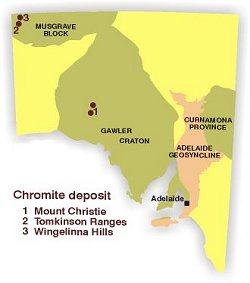 Chromite, a brownish black cubic mineral belonging to the spinel group, is the only ore mineral from which metallic chromium and chromium compounds are obtained. It has the chemical formula FeCr2O4, and a theoretical composition of 32.0% FeO and 68.0% Cr2O3. In its natural form it occurs in solid solution with other minerals in the spinel group, so chrome contents are less than the theoretical 68%. The most important use of chrome is in production of high-strength alloys and alloys which are heat, abrasion, corrosion and oxidation resistant. Approximately half of all chromite production goes into the manufacture of stainless steel. Chromium chemicals are used for many purposes; pigments, photography and plating being but a few. Chromite is used as a refractory in the production of steel, copper, glass and cement.
Chromite, a brownish black cubic mineral belonging to the spinel group, is the only ore mineral from which metallic chromium and chromium compounds are obtained. It has the chemical formula FeCr2O4, and a theoretical composition of 32.0% FeO and 68.0% Cr2O3. In its natural form it occurs in solid solution with other minerals in the spinel group, so chrome contents are less than the theoretical 68%. The most important use of chrome is in production of high-strength alloys and alloys which are heat, abrasion, corrosion and oxidation resistant. Approximately half of all chromite production goes into the manufacture of stainless steel. Chromium chemicals are used for many purposes; pigments, photography and plating being but a few. Chromite is used as a refractory in the production of steel, copper, glass and cement.
Chromite occurs as a primary accessory mineral in basic and ultrabasic igneous rocks. Economic deposits form by crystallisation of chromite from a cooling magma, resulting in large stratiform deposits or smaller pod-like deposits. The most significant occur in large, layered, igneous intrusions in shield areas older than 1.9 billion years. The largest and best known of these is the Bushveld Complex (Republic of South Africa), which extends over 12,000 km2 and contains 60% of the world's known chromite reserves.
The word mine production of chromite is about 26 Mt (2013) with South Africa (42%), Kazakhstan (15%) and India (15%) the major producers in addition recycling accounts for about 50% of consumption.
Australia's only significant chromite deposit, Coobina, is a stratiform deposit in the Pilbara region of Western Australia, with a possible resource of 1.5 Mt at 29.4% Cr. The mine produced 452,000 t of chromium in 2012.
South Australian chromite
In South Australia, chromite was intersected in drillholes south and southwest of Mount Christie in a zone of intermediate to ultramafic rocks of Paleoproterozoic age. The best intersection was 1.5 m at 9.8% Cr2O3. Microprobe analysis showed the chromite to contain ~48% Cr2O3 and 30% FeO, which may only be suitable as chemical-grade chromite. Chemical composition is typical of chromite found in layered ultramafic complexes.
Chromite has been identified within Mesoproterozoic Giles Complex rocks in the far northwest of the State. It occurs as rare veins up to 10 mm thick within layers of pyroxenite in the Tomkinson Ranges (Coats 1956) and as grains in ultrabasic rocks of the Wingellina Hills intrusions. A representative sample gave an assay of 16.9% Cr2O3.
Additional reading
Coats RP 1956. Occurrence of chromite at Mount Davies, Tomkinson Range. Mining Review 101:46.
Morris BJ, Hill PW and Ferris GM 1994. Barton bedrock drilling program. Report Book 94/19. Department of Mines and Energy, South Australia.


